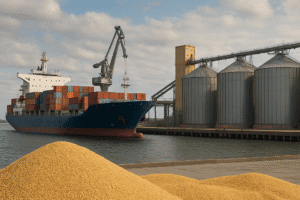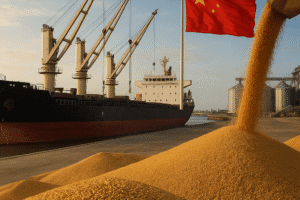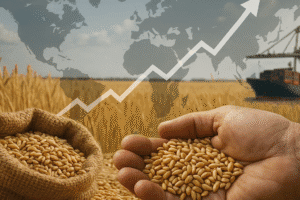Exploring grain export hubs reveals the critical role that major ports and regions play in the global agricultural economy. As the demand for grains continues to rise due to population growth and changing dietary preferences, understanding the logistics and infrastructure of grain exportation becomes increasingly important. This article delves into the key grain export hubs around the world, examining their significance, the challenges they face, and the future of grain trade.
Major Grain Export Hubs
Grain export hubs are strategically located ports and regions that facilitate the movement of grains from producers to consumers across the globe. These hubs are essential for ensuring that grains reach international markets efficiently and cost-effectively. Some of the most significant grain export hubs include:
- United States: The U.S. is one of the largest grain exporters in the world, with key hubs located in the Midwest, particularly in states like Illinois, Iowa, and Nebraska. The Port of New Orleans is a vital export point, handling a significant portion of the country’s grain shipments.
- Brazil: As a leading exporter of soybeans and corn, Brazil’s grain export hubs are concentrated in the central and southern regions. The Port of Santos is the largest and most important port for grain exports, facilitating trade with countries in Asia and Europe.
- Ukraine: Known as the „breadbasket of Europe,” Ukraine has emerged as a major grain exporter, particularly of wheat and corn. The ports of Odessa and Mykolaiv are crucial for exporting these grains, especially given the country’s fertile soil and favorable climate.
- Russia: Russia has rapidly increased its grain exports in recent years, with key ports such as Novorossiysk and Rostov-on-Don playing significant roles in the global grain market. The country’s vast agricultural land and favorable growing conditions contribute to its export capacity.
- Australia: Australia is a major exporter of wheat and barley, with key export hubs located in ports like Port Hedland and Brisbane. The country’s agricultural sector is heavily reliant on these ports for international trade.
Challenges Faced by Grain Export Hubs
While grain export hubs are vital for global trade, they face several challenges that can impact their efficiency and effectiveness. Some of the most pressing issues include:
Infrastructure Limitations
Many grain export hubs struggle with outdated infrastructure, which can lead to bottlenecks in the supply chain. Insufficient storage facilities, inadequate transportation networks, and limited port capacity can hinder the timely export of grains. Upgrading infrastructure is essential to meet the growing demand for grain exports.
Geopolitical Factors
Geopolitical tensions can significantly impact grain export hubs, particularly in regions like Eastern Europe and the Middle East. Conflicts, trade disputes, and sanctions can disrupt supply chains and limit access to key markets. For instance, the ongoing conflict in Ukraine has created uncertainty in the global grain market, affecting prices and availability.
Climate Change
Climate change poses a significant threat to grain production and exportation. Extreme weather events, such as droughts and floods, can devastate crops and disrupt supply chains. Grain export hubs must adapt to these changes by implementing sustainable practices and investing in resilient infrastructure to mitigate the impacts of climate change.
Market Volatility
The global grain market is subject to fluctuations in demand and supply, which can affect export hubs. Price volatility can impact farmers’ decisions on what to plant, leading to potential shortages or surpluses. Export hubs must navigate these market dynamics to ensure a steady flow of grains to international markets.
The Future of Grain Export Hubs
As the global population continues to grow and dietary preferences shift, the demand for grains is expected to rise. This presents both opportunities and challenges for grain export hubs. The future of these hubs will likely be shaped by several key trends:
Technological Advancements
Advancements in technology are poised to revolutionize grain exportation. Innovations in logistics, such as blockchain for supply chain transparency and automation in port operations, can enhance efficiency and reduce costs. Additionally, precision agriculture technologies can improve crop yields, ensuring a steady supply of grains for export.
Sustainability Initiatives
With increasing awareness of environmental issues, sustainability will play a crucial role in the future of grain export hubs. Implementing sustainable farming practices, reducing carbon footprints, and investing in renewable energy sources will be essential for maintaining competitiveness in the global market. Export hubs that prioritize sustainability will likely attract more buyers who are conscious of their environmental impact.
Global Trade Agreements
Trade agreements will continue to shape the landscape of grain exportation. As countries negotiate new agreements, grain export hubs must adapt to changing regulations and market access conditions. Strengthening trade relationships can open new markets for exporters, enhancing the overall efficiency of grain trade.
Investment in Infrastructure
To remain competitive, grain export hubs must invest in modernizing their infrastructure. This includes expanding port facilities, improving transportation networks, and enhancing storage capabilities. Governments and private investors will need to collaborate to ensure that these hubs can meet the growing demand for grain exports.
Conclusion
Grain export hubs are vital components of the global agricultural economy, facilitating the movement of grains from producers to consumers. As the demand for grains continues to rise, understanding the significance of these hubs, the challenges they face, and the trends shaping their future is essential. By investing in infrastructure, embracing technological advancements, and prioritizing sustainability, grain export hubs can enhance their efficiency and effectiveness in the global market. The future of grain trade will depend on the ability of these hubs to adapt to changing conditions and meet the needs of a growing population.













